EEG-Assisted Meditation
Whether you are new to meditation or seeking to take your existing practice to the next level, we are here to help.
In the past few decades, meditation has become increasingly appreciated and accepted in the west. There are countless research studies demonstrating its benefit for mental and physical well-being. Many people who come into our office have tried meditation, though most have found it difficult to maintain a consistent practice. One of the challenges is the sheer variety of meditation techniques. Different styles yield different results, and some methods are better suited for beginners with wandering minds whereas others are more appropriate to seasoned practitioners with a high degree of mental focus.
For decades now, scientists have been studying the effects of meditation on the brain, including analyzing the brain wave patterns of advanced individuals undergoing deep meditation. There is still much to learn, as the brain is the most sophisticated object in the known universe. However, certain meditation techniques generate predictable and desirable states of consciousness and these have been linked to unique brain wave patterns. Now that the technology exists to guide brainwaves into desired patterns, we have the ability to assist people in reaching meditative states of consciousness at an exponentially accelerated rate.
People have used EEG-based biofeedback (neurofeedback) to assist in meditation since scientists started studying it decades ago. However, the field has recently been making giant leaps thanks improving technologies and the work of Jeff Tarrant. He has distilled five main categories of meditation and their associated states of consciousness, each of which we can induce with a combination of meditation instruction and neurofeedback. The following is taken from The NeuroMeditation Institute.
Five Types of Meditation

Focus Meditation: Having difficulty staying focused or completing tasks? Focus meditation improves voluntary control of attention and cognitive processes. This style might be best for you if you want to improve your focus and concentration and reduce your mind wandering.
Mindfulness Meditation: Looking for more impulse control and emotional stability? Mindfulness practice has become very popular, especially with the medical field. Mindfulness consists of a dispassionate, non-evaluative awareness of ongoing experience. You might choose to practice this style if you want to get better at letting things go and reducing internal judgment.
Quiet Mind Meditation: Looking to cultivate nondual or transcendent experience? Quiet Mind meditations lead to automatic transcending of the procedures of the meditation practice that leads to an open awareness. This practice is ideal if you are interested in minimizing internal self-talk and learning to achieve a state of restful awareness.
Open Heart Meditation: Seeking to increase compassion and well-being? Open Heart meditation leads to activation of positive emotional states (e.g., love, compassion, peace) along with an unrestricted readiness to help all living beings. Meditations in this category are ideal for increasing empathy, generosity and perspective taking.
By understanding the differences between meditation styles, you can choose a style of meditation practice to match your goals.
About Dustin Johnson LPC
I am a huge proponent of meditation, having practiced it for nearly two decades here and in India. Given our fast-paced and technological culture, I believe that a regular meditative practice is mandatory for a sense of mental well-being. I find that most people don’t recognize how anxious and stressed they are until they experience a moment of deep physical and mental relaxation. It is very exciting to live in Fort Collins, and Colorado in general, which is a hot spot for so many types of consciousness-expanding opportunities and contemplative traditions. Read more about me here.


